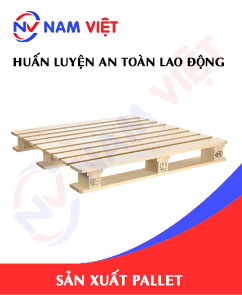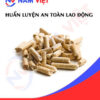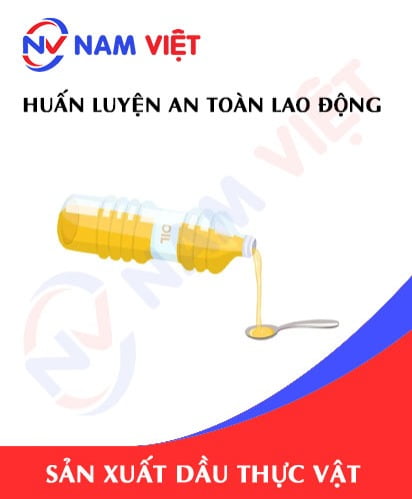Occupational Safety Training for Pallet Manufacturing
99,000 ₫
Note: The above price is calculated for one person, and the price may fluctuate depending on the number of learners participating in the course and market movements. For more accurate pricing support, please refer to the price list or contact our consulting staff directly.
Occupational safety is an important issue in pallet manufacturing factories and needs to be addressed promptly to ensure the health and safety of workers and enhance the reputation of enterprises. The Occupational Safety Training course is one of the effective solutions to raise awareness on how to prevent workplace accidents for workers participating in pallet manufacturing.
Table of Contents
Toggle1. Overview of pallet
a. What is a pallet?
A pallet is a unit for transporting and storing goods that is widely used in logistics and warehousing. It is a flat platform, usually made of wood, plastic, or metal, with standard dimensions so it can be moved and stacked during the process of transporting and storing goods.
Pallets usually have dimensions of 800 mm x 1200 mm or 1000 mm x 1200 mm, however, there are also other sizes used in different regions around the world. Some pallets have non-standard sizes to meet the special requirements of certain industries.
Using pallets allows goods to be moved easily by using forklifts or similar handling equipment. This helps increase transportation efficiency, reduce the time and effort needed for loading, unloading, and storing goods. Pallets also help protect goods by creating a stable platform and providing support when goods are stacked on top of each other.

b. Types of machines in pallet manufacturing
There are several types of machines involved in the pallet manufacturing process. Below are some examples of commonly used machines:
- Saw machine: Used to cut wood boards or other materials into long and wide pieces to form pallet components.
- Sanding machine: Used to sand the surface of pallet components, remove sharp edges, and smooth the surface.
- Pressing machine: Functions to press pallet wood components or other materials together using pressure and temperature to create a solid structure.
- Assembly machine: Used to assemble pallet components together. Nails, glue, or other joining methods can be used to connect the components into a complete pallet.
- Edging machine: Used to create edges for pallet components by attaching protective strips around the pallet edges.
- Grinding machine: Used to flatten and create a finished surface for pallets after the manufacturing process.
- Printing machine: Used to print labels, barcodes, or logos on pallets to identify products or other important information.
These machines help increase productivity and quality in pallet manufacturing while reducing the effort and time required compared to manual production. However, the specific machines used in the pallet manufacturing process may vary depending on the scale and technology of each pallet factory.

c. Pallet manufacturing enterprises in Vietnam
There are many pallet manufacturing enterprises in Vietnam. Here are some examples:
- Hoa Phat Manufacturing and Trading Company Limited: Hoa Phat is one of the leading companies in pallet manufacturing in Vietnam. They manufacture pallets from wood and plastic, supplying diverse products for many industries.
- Tien Thanh Plastic Company Limited: Tien Thanh is one of the leading enterprises in plastic pallet manufacturing in Vietnam. They manufacture pallets from composite plastic, recycled plastic, and new plastic, meeting the needs of different industries.
- Binh Duong Wood Manufacturing Joint Stock Company: Binh Duong Wood is an enterprise specializing in wood pallet manufacturing in Vietnam. They supply high-quality wooden pallet products for transportation and warehousing companies.
- Minh Hung Phat Company Limited: Minh Hung Phat is an enterprise specializing in wooden pallet manufacturing in Vietnam. They supply both standard and non-standard wooden pallets for many domestic and international customers.
- Binh Minh Plastic Company Limited: Binh Minh Plastic is a plastic pallet manufacturing enterprise in Vietnam. They manufacture high-quality, durable plastic pallet products with diverse sizes and designs.
These are only some examples and not a complete list. Vietnam has many other enterprises supplying pallet products for the domestic market and export.

d. Specific jobs in pallet manufacturing factories
Group 1
- Executive director, deputy executive director, department heads in pallet manufacturing factory
Group 2
- Safety officer: manage safety in the factory, design safety procedures, supervise and enforce workers to comply with safe working procedures.
Group 3
- Material preparation: This job includes preparing necessary materials such as wood, plastic, glue, nails, and other components.
- Cutting and processing materials: Materials such as wood or plastic will be cut into sheets or bars with dimensions and shapes suitable for pallet requirements.
- Fabrication of pallet components: Pallet components, including wooden boards or plastic bars, will be fabricated and cleaned to prepare for assembly.
- Assembly of pallets: Pallet components will be joined and assembled together to form a complete pallet. This process may use nails, glue, or other joining methods.
- Inspection and quality check: Finished pallets will be checked for quality to ensure they meet required standards and specifications. Factors such as durability, dimensions, and load capacity will be tested.
- Finishing and packaging: After quality inspection, pallets will be finished by grinding, painting, printing logos or labels, and packaging for transportation and delivery.
Group 4
- Office, service, sales, and marketing jobs.
- Production management, quality management, human resources management, material management, finance and accounting management.
- Research and development of new products, product packaging design.
2. Overview of occupational safety training for pallet manufacturing
Within the scope of this article, we focus on issues related to group 3, because group 3 directly participates in the manufacturing process and is at the highest risk of occupational safety. Refer to other groups here
a. What is group 3 occupational safety training?
- Occupational safety training for group 3 includes lessons that provide awareness about accident prevention for workers.
- The occupational safety training course will help workers identify and avoid hazards, limiting risks of workplace accidents during work.
REGISTER FOR OCCUPATIONAL SAFETY TRAINING SERVICE
b. Training duration
Initial occupational safety training duration
- Total training duration is at least 24 hours, including examination time.
- 8 hours of theory on occupational safety and hygiene policies and laws
- 8 hours of theory on basic knowledge of occupational safety and hygiene
- 4 hours of theory on specialized training content
- 2 hours of practice on specialized training content
- 2 hours of theoretical examination at the end of the training
The occupational safety training center will allocate time into several sessions depending on workers’ schedules. Typically, there will be 6 sessions, lasting 3 days, provided that the manufacturing enterprise can arrange continuous study time.
Periodic occupational safety training duration
- Before the occupational safety card expires, workers who wish to renew must undergo a periodic occupational safety training course, with training duration equal to at least 50% of the initial training duration.
Explanation: the total periodic occupational safety training duration is at least 12 hours, including examination time. After completing the periodic training course and passing the examination, workers will be reissued or have their occupational safety card extended.
c. Training content
| No. | TRAINING CONTENT | TRAINING DURATION (HOURS) | |||
| Total | Including | ||||
| Theory | Practice | Examination | |||
| I | System of occupational safety and hygiene policies and laws | 8 | 8 | 0 | 0 |
| 1 | Overview of the system of legal documents on occupational safety and hygiene. | 6 | 6 | ||
| 2 | System of standards and technical regulations on occupational safety and hygiene. | 1 | 1 | ||
| 3 | Specific regulations from state management agencies on occupational safety and hygiene when building, expanding, or renovating facilities for manufacturing, using, storing, preserving, and inspecting machines, equipment, materials, and substances requiring strict occupational safety and hygiene. | 1 | 1 | ||
| II | Basic knowledge of occupational safety and hygiene | 8 | 8 | 0 | 0 |
| 1 | Basic knowledge of hazardous and harmful factors in the workplace. | 4 | 4 | ||
| 2 | Methods of improving working conditions. | 1 | 1 | ||
| 3 | Safety culture in manufacturing and business. | 1 | 1 | ||
| 4 | Rights and obligations of employers and employees; occupational safety and hygiene policies for employees; functions and duties of the occupational safety and hygiene network. | 1 | 1 | ||
| 5 | Rules on occupational safety and hygiene, safety signs, occupational hygiene signs, and the use of safety equipment, personal protective equipment; skills in first aid for occupational accidents, prevention of occupational diseases. | 1 | 1 | ||
| III | Specialized training content | 6 | 4 | 2 | 0 |
| Comprehensive knowledge of machines, equipment, and substances generating hazardous and harmful factors; analysis, assessment, risk management of occupational safety and hygiene, safe working procedures with machines, equipment, and substances requiring strict occupational safety and hygiene. | 6 | 4 | 2 | ||
| IV | Examination of occupational safety training content at the end of the course | 2 | 2 | 0 | 0 |
| Total | 24 | 22 | 2 | ||
See more training content of 6 groups
d. Occupational safety card
After completing the occupational safety training course and passing the examination, workers will be issued an occupational safety card (commonly referred to as occupational safety certificate group 3).
The group 3 safety card clearly shows information such as full name, date of birth, job, and specific working environment. It also includes training duration, red seal, and signature confirming course completion.
According to the regulations on card issuance stated in Clause 2 Article 24 Decree 44/2016/ND-CP, it is divided into 2 cases:
- If the employer and employee have a labor contract, the employer must sign, stamp, and seal the safety card for the group 3 trained worker after completing the training from the occupational safety training unit and passing the examination.
- If the worker is a freelancer, seasonal, without a labor contract, the training unit must sign, stamp, and seal the safety card after the worker has completed training from the occupational safety training unit and passed the examination.

3. Identifying hazards affecting workers in pallet manufacturing
The pallet manufacturing process may involve several potential hazards for workers. Below are some main hazards and how to identify them:
- Injuries from mechanical impacts: During the cutting, joining, and assembling of pallets, there is a risk of injuries from cutting tools, nails, glue, and other components. To identify this hazard, it is necessary to check safety procedures and provide workers with personal protective equipment (including safety glasses, helmets, gloves, and safety shoes) and training on how to use them.
- Fire and explosion risk: If the pallet manufacturing process involves the use of flammable materials or flammable liquids, such as glue or coloring substances, the risk of fire and explosion may increase. To identify this hazard, the factory must be designed and arranged with good ventilation, effective fire prevention and firefighting systems, and compliance with fire safety regulations.
- Chemical exposure: Pallet manufacturing may involve the use of glue, paint, or other coloring substances, which can be hazardous to health if not handled properly. To identify this hazard, it is necessary to ensure that all chemicals used comply with safety regulations, provide effective ventilation systems, and ensure workers are trained in safe handling and protection when exposed to chemicals.
- Load and transportation issues: Pallets may be transported and stacked with goods on top. Failure to comply with safe load regulations and guidelines can lead to accidents such as falling loads, collapse, or crushing injuries.
- Electrical hazards: If electrical equipment in the factory is not regularly maintained, not properly insulated, or not waterproofed, it may cause electrical shock hazards to workers during the manufacturing process.
4. Common types of occupational accidents for workers in pallet manufacturing
There are several common types of occupational accidents that may occur when workers participate in the pallet manufacturing process. Below are some examples:
- Cuts and injuries from tools and materials: There is a risk of injury from the use of cutting tools such as knives, saws, or cutting machines, as well as from contact with sharp materials and edges. These may include accidents such as hand cuts, puncture wounds, or scratches from wooden or plastic materials.
- Slips, trips, and falls from height: During movement, stacking, or transporting pallets, there is a risk of falling, tripping, or falling from height, which may cause serious injuries such as bone fractures, head injuries, internal organ damage, and spinal injuries.
- Injuries from equipment and machinery: When working near machines and equipment, there is a risk of collisions, crushing, entanglement, or body parts being trapped. These may occur from collisions with forklifts, saws, presses, or other components during the pallet manufacturing process.
- Injuries from improper load handling: If pallets are not designed or used within safe load limits, the risk of falling loads, collapse, or insufficient load capacity may cause worker injuries. This may occur when stacking pallets too high or failing to follow safe load guidelines.
- Chemical exposure: The use of materials such as glue, paint, or coloring substances may cause injuries or health issues for workers if safety regulations regarding the use and handling of chemicals are not followed.

5. Safety measures in pallet manufacturing
When participating in pallet manufacturing, it is necessary to apply safety measures to protect workers. Below are some important safety measures that can be applied:
- Ensure safety training: Provide safety training for all employees involved in pallet manufacturing. This training should include safe work procedures, the use of personal protective equipment, risk management, and hazard awareness in the manufacturing process.
- Use personal protective equipment: Ensure that all employees are provided with and correctly use personal protective equipment such as safety glasses, helmets, gloves, safety shoes, and air filters. This helps protect workers from injury risks, chemical exposure, and other factors.
- Organize a safe working environment: Ensure a spacious, clean, and well-organized workspace to reduce the risk of collisions, slips, trips, and other accidents. Place safety signs and designated pathways to guide workers safely.
- Inspect and maintain equipment: Perform regular inspections and maintenance of equipment and machinery used in the pallet manufacturing process. This helps ensure they operate safely and efficiently, reducing the risk of accidents caused by breakdowns or technical failures.
- Chemical management: For processes involving chemicals such as glue, paint, or coloring substances, ensure compliance with safety regulations regarding storage, use, and handling. Provide workers with guidance on safe handling and protection when exposed to these substances.
- Regularly conduct occupational environment monitoring in factories, collect and analyze harmful factors for workers, and adjust to reduce hazards to prevent occupational diseases.
6. Benefits of occupational safety training in pallet manufacturing
An Toan Nam Viet provides businesses with excellent benefits after completing occupational safety training courses in accordance with Decree 44/2016/ND – CP on occupational safety and hygiene for companies, factories, and enterprises.
- Workers can identify potential risks of occupational accidents and implement preventive measures to avoid accidents.
- Businesses can establish preventive measures for risks in manufacturing, operation, and maintenance processes.
- Minimize costs when occupational safety risks occur.
- Uninterrupted production helps increase labor productivity and product quality.
- Comply with labor safety regulations, avoiding legal risks.
- Create credibility and professionalism in all aspects, thereby enhancing the brand reputation for businesses.
The training courses of An Toan Nam Viet are preventive solutions against external factors that may affect individuals, helping them avoid dangers that could lead to injuries or even fatalities.
REGISTER FOR OCCUPATIONAL SAFETY TRAINING SERVICES
7. Customer feedback after completing occupational safety training in pallet manufacturing
An Toan Nam Viet has many years of experience in the mission of accompanying many businesses in Vietnam in general and especially in the southern provinces. That responsibility is extremely valuable to Nam Viet, which is why the occupational safety training work of Nam Viet is always increasingly professional. The motivation for An Toan Nam Viet to grow stronger comes from the positive feedback and contributions from businesses. Below are the feedbacks from our partners we have served.
Bac Nam E&C Construction Investment Joint Stock Company
“This was the first time using the service at An Toan Nam Viet and I was very surprised by the 24/7 enthusiastic support from the consulting team. The class organization was very quick and convenient for our company, thank you very much Nam Viet for your service!”
Hoa Dat Construction and Trading Joint Stock Company
“The service of Nam Viet has greatly helped us simplify occupational safety and complete safety documents for the work process. The consulting team is enthusiastic and timely in answering our questions. 5 stars for Nam Viet.”
See more customer interviews after using the service of An Toan Nam Viet
8. Occupational Safety Training Capacity of An Toan Nam Viet
An Toan Nam Viet is a reputable and high-quality occupational safety training center in Vietnam today. With occupational safety training sessions continuously held at manufacturing workshops, factories, or construction sites across the country (63 provinces and cities in Vietnam).
REGISTER FOR OCCUPATIONAL SAFETY TRAINING SERVICES
Occupational safety training license
- An Toan Nam Viet has been inspected and certified by the Occupational Safety Department of the Ministry of Labor – Invalids and Social Affairs with the license of eligibility for occupational safety and hygiene training activities. This further strengthens our occupational safety training capacity.

Training materials and lectures
- Before occupational safety training materials are applied to occupational safety training courses, they are reviewed and approved to ensure that the lectures are always accurate in knowledge and effective when applied.
- The teaching methods of instructors are standardized according to the teaching standards of An Toan Nam Viet, which are methods researched and summarized by experts in occupational safety and hygiene training to bring the highest knowledge acquisition efficiency for learners.
Facilities
- Controlling classroom factors that affect training increases teaching performance and the effectiveness of knowledge acquisition by learners.
- Training support facilities are always equipped with spacious classrooms that meet standards for area, lighting, training equipment, etc.
9. Nationwide reputable and quality occupational safety training center
At An Toan Nam Viet, we always prioritize dedication in occupational safety training. For us, conveying the knowledge of self-protection to workers so that they can have a safe foundation on their livelihood journey is a contribution to building the country.
To ensure effective training, we prepare carefully and meticulously down to the smallest details. From preparing tools, teaching equipment, curriculum, materials, sound, and lighting.
Our occupational safety training instructors are experts with many years of experience in the field. They even have research projects on identifying hazards in all industries and ways to prevent them.
Lectures are summarized from practical experience and delivered in a vivid and understandable way to workers. These factors make workers feel comfortable during the learning period and effectively absorb the knowledge delivered. Of course, the knowledge provided is always consistent with Decree 44/2016/ND-CP.
From there, workers can master many measures to prevent hazards and protect themselves. At the same time, they can apply it most appropriately in their actual work.
Our occupational safety training center is proud to be a reputable and professional provider of occupational safety training services with the following advantages:
- Competitive training costs while maintaining training quality.
- Flexible training schedules adapted to the manufacturing situation of businesses.
- Quick occupational safety training certification procedures in accordance with the law.
- Instructors with many years of professional experience.
- Classrooms are controlled with factors that improve teaching performance and learning efficiency.
- Lectures compiled to suit occupational safety work at businesses.
- An Toan Nam Viet works dedicatedly and professionally to provide customers with accurate and fast support.

10. Additional reference materials for occupational safety training in pallet manufacturing
- Occupational safety materials for pallet manufacturing
- Occupational safety training document set
- Occupational safety training test set
- Occupational safety multiple-choice test for pallet manufacturing
- Slides of occupational safety training lectures for pallet manufacturing
1 review for Occupational Safety Training for Pallet Manufacturing
No comments yet















namchinh.haiphong341
Hài lòng nhé!